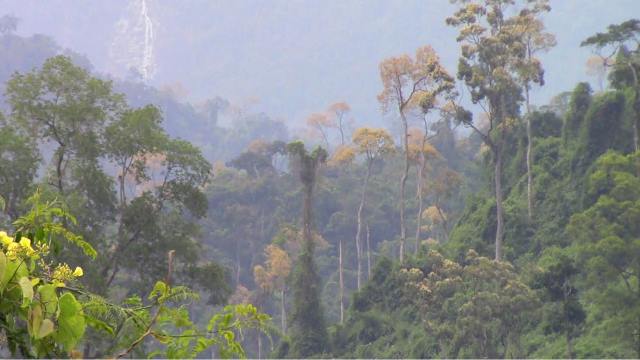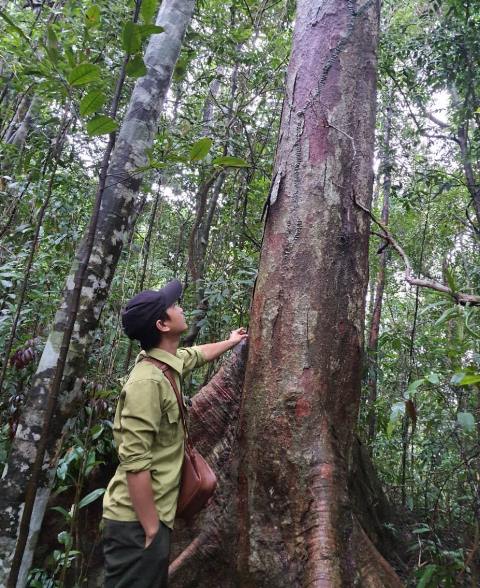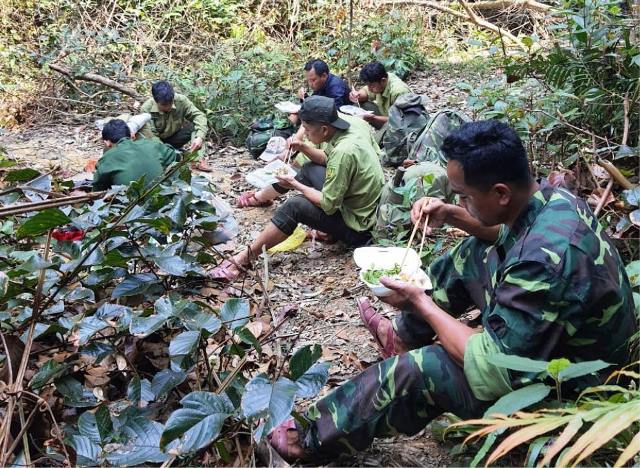
S.macropodum trees in full bloom in Bach Ma National Park
"Mutant" S.macropodum trees
"It's been a long time since we had last seen such a "blooming" season of S.macropodum trees. To a certain extent, healthy S.macropodum trees can be credited to the conservation and protection work of the forest rangers. But the work can be rather grueling for us,” confided Mr. Tran Chau Long, Head of the Mobile Forest Protection Station and Forest Fire Protection Station (Bach Ma Forest Protection Department), when referring to this year's "mutant" S.macropodum tree forest.
The S.macropodum tree is an overgrown tree, mostly distributed in the low mountain areas. The S.macropodum tree’s cycle of flowering and bearing fruit is approximately once every 4 years. In Bach Ma forest, the malva nut (the nut of S.macropodum tree) season was the most abundant in 2014. However, compared to this year (2021), the malva nut season has not only come a year earlier but also with a "mutation" in the bountiful number of trees flowering and bearing fruit. There are S.macropodum trees that are only about 3-4m high producing flower and bearing fruits, and they are distributed near residential areas. Thus, the protection work is even more focused.
The La Son - Tuy Loan highway passes through Bach Ma national forest, inadvertently cutting through the S.macropodum tree forest at the foot of Do Quyen Waterfall. S.macropodum trees are densely distributed on the roadside, close to the forest gates and spreading across the communes of Thuong Nhat, Huong Phu, Huong Loc, Thuong Lo (Nam Dong).

The result of patrolling and protecting the forest is safeguarding old trees
The malva nuts are predicted to ripen from mid-June to the end of July this year. Because the malva nut is used as an herbal medicine or in beverage preparation, it has economic value and is very popular on the market. The harvesting of the malva nuts brings significant income to local people.
Local people's method of harvesting malva nuts has mainly been cutting down S.macropodum trees to get the malva nuts. This method is destructive and causes serious damage to forest resources.
On one occasion, I had the chance to accompany the forest rangers of Bach Ma National Park into the Mo Rang area. Looking at the S.macropodum tree forest blooming at the foot of Do Quyen Waterfall, Mr. Tran Chau Long said that 95% of the trees were in full bloom. With the blooming season like this year, the park rangers had planned to patrol and protect forests early on and to fortify barricade forces 100%, including the holidays.
The S.macropodum trees are distributed near residential areas, where the La Son - Tuy Loan highway passes through the center of Bach Ma National Park, so it inadvertently facilitates transportation for those involved in malva nuts exploitation.
Thriving forest - rangers… "suffer"
Mr. Tran Dinh Huy, Deputy Head of Bach Ma’s Mobile Forest Protection Station and Fire Protection Station, said that according to current regulations, the collection of non-timber forest products in general and malva nut in particular in special-use forests is not licensed. Therefore, the development of a plan for management and protection of S.macropodum trees is an urgent measure in the current actual situation to manage and protect S.macropodum trees in the area of Bach Ma National Park.

Quickly eating a bowl of rice at the edge of the forest
The unit has planned to arrange checkpoints and forest ranger stations in the communes and key areas of Thuong Nhat, Thuong Lo (Nam Dong), Loc Hoa (Phu Loc) and Dong Giang (Quang Nam) with 12-19 rangers per station. At the same time, coordinate with local authorities and police forces to handle those who illegally exploit S.macropodum trees.
In particular, in the area of the garden, the forest rangers in the 4 reservoirs of the hydropower plant must strengthen their force to 100% patrol, control and protect the S.macropodum tree forest, even on holidays.
The blooming season of S.macropodum trees is also the time when forest rangers' footprints are to imprint on the old forests. Being able to sit and talk, go on a field trip in the S.macropodum tree forests along the highway, we can see all the difficulties that the forest rangers are facing and the dangers when carrying out forest protection work.
Recalling the old story, Vo Truong Son, a ranger, who accompanied me said that the forest patrol was always facing danger, so the rangers had to be careful with every step on the stone slab and mound.
Once, at the end of 2020, Le Anh Huu (a ranger of Mo Rang Ranger Station in Huong Loc commune), during a night patrol with 3 other colleagues, was crushed on the leg by a stone rolling from the mountainside.
On the one hand, the other rangers gave first aid to the wound, providing information with the unit to increase strength to give them support. They used hammocks and stretchers to bring Mr. Huu home for treatment. The route back was very arduous and strenuous, passing through many streams with waterfalls and large orphaned rocks. In some parts, they had to abandon his hammock to carry him on back because he couldn't walk. After 10 hours of persistently climbing the mountain and crossing the waterfall, at exactly 3 a.m. the next morning, the rangers could bring Mr. Huu back to the station safely.
The story of forest rangers protecting the forest not only occurs during the malva nut season, but also stands daily in the old forests because the forces at the stations are quite few, while having to "stretch their eyes" to protect the entire area of nearly 40,000 hectares of forest throughout the garden.
The accidents in the forest patrol sometimes are not simply a mission anymore, but they turn to be beautiful memories of comradeship and mutual support.
In early 2021, during a patrol, and while setting up camps at 43 Khe Me sub-zone, the forest rain and flash flood suddenly came and swept away many of the camps that the rangers had just built, but fortunately there were no human casualties.
Join hands to protect
Mr. Tran Chau Long, Head of Bach Ma’s Mobile Forest Protection Station and Forest Fire Prevention and Control Station, affirmed that, thanks to close monitoring of the situation, from the beginning of April 2021, Bach Ma Forest Protection Department has carried out a survey of the area where the S.macropodum trees are flowering to develop a protection plan.
The unit coordinates with the Forest Protection Departments of Phu Loc and Nam Dong districts, localities, and relevant agencies to raise awareness and convince people not to go to the S.macropodum forest to collect malva nuts. The unit also coordinates with the forest protection management boards of Dong Giang and Nam Dong, of Ba Na - Nui Chua special-use forest, Quang Nam Sao La Conservation Area and Nam Hoa Forestry One Member Company Limited, to support one another in sharing information and raising awareness on the protection of forests in the bordering areas.
In particular, all forest protection stations must implement regular patrols to monitor, patrol and control the key bordering areas where S.macropodum trees are bearing fruits until the end of the season.
In order to manage and protect the forests effectively, Bach Ma National Park has recently used Smart Mobile, Smart Connect, Smart Online tools and applied WebGis for forest patrol and protection to easily track the patrolling route, locate on maps, and help manage data in a smart, fast, accurate, transparent and efficient way.
Story and photos: Ha Nguyen